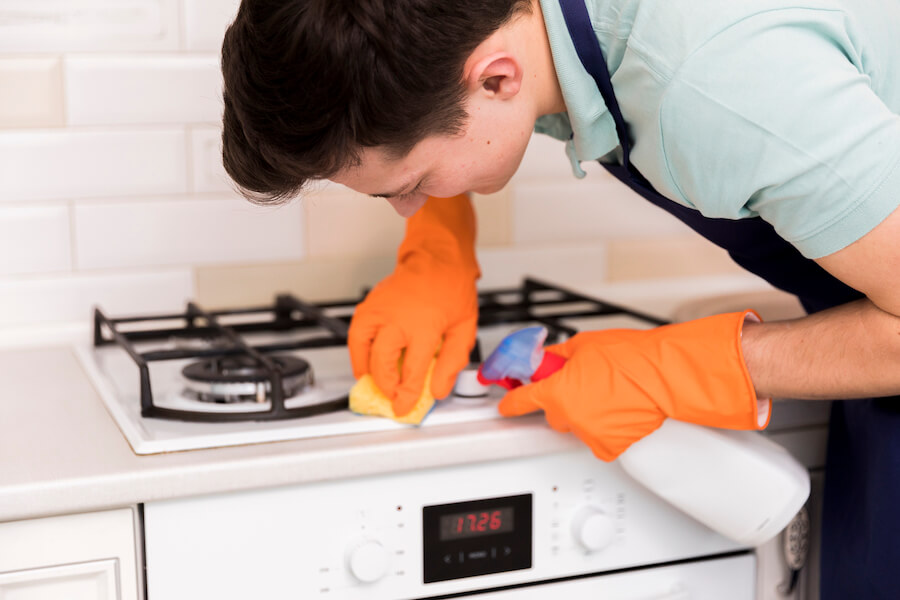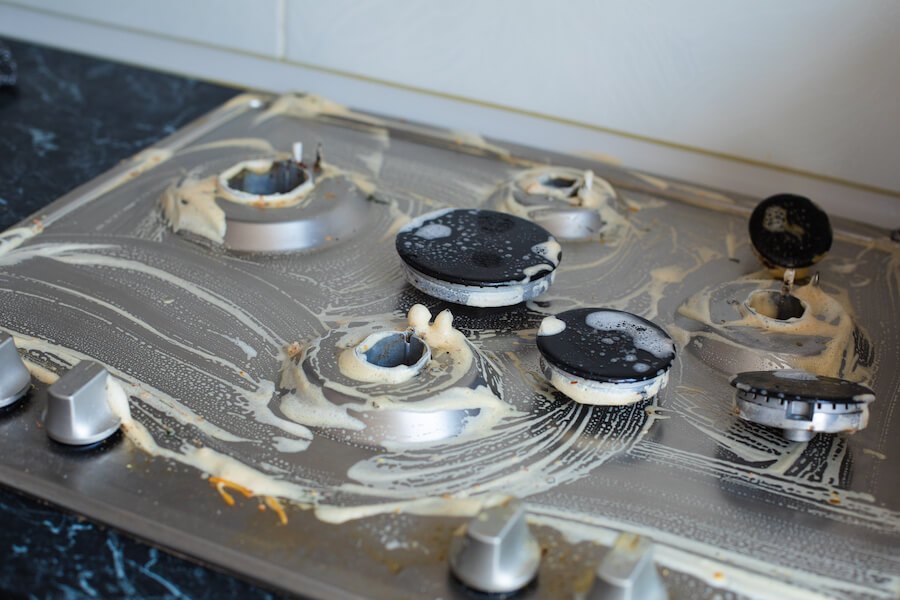A gas stove is a reliable and essential appliance in many households, but it can sometimes become frustrating when it starts clicking incessantly after cleaning.

This persistent clicking sound, often accompanied by the igniter attempting to spark, can be annoying and concerning.
However, before you panic and call in a professional, it’s essential to understand the common causes behind this issue and the practical solutions you can implement to resolve it.
This article will explore why a gas stove is clicking after cleaning and how to tackle each effectively.
Dirty Igniter
Sometimes, we clean and forget to touch the right corners and places, including the igniter, which can cause a clicking sound.
One of the primary reasons your gas stove might keep clicking is a dirty igniter. When you turn on a burner, the igniter creates a spark to ignite the gas.
Over time, grease, food particles, and residue from previous cooking can accumulate on the igniter, hindering its ability to generate a spark.
Cleaning the igniter thoroughly with a soft brush or a cotton swab dipped in rubbing alcohol can often resolve this issue.
Solution: Inspect and Replace the Igniter
The igniter plays a pivotal role in lighting the gas burner, and a faulty one can lead to ignition problems. To begin, consult your stove’s manual for specific instructions tailored to your model, as procedures can vary.
During inspection, carefully examine the igniter for visible wear, damage, or corrosion. These issues can hinder its effectiveness and reliability. If any such problems are detected, it’s essential to replace the igniter promptly to ensure consistent ignition.
Select a compatible replacement part that matches your stove’s specifications when replacing the igniter. An incompatible igniter may not function correctly and could create safety hazards.
Properly maintaining the igniter ensures your gas stove’s safe and efficient operation, promoting both safety and convenience in your kitchen.
Wet Burner Components
Moisture is another culprit that can lead to constant clicking. If you’ve recently cleaned your gas stove using water or a damp cloth, some moisture may have found its way into the burner components.
The presence of water can disrupt the spark and cause clicking. Ensure all burner components are dehydrated before using the stove to address this.

Solution: Proper Drying
Moisture has a knack for finding its way into even the tiniest crevices and components of your gas stove, especially if you’ve recently cleaned it using water or a damp cloth.
When water or moisture infiltrates the burner components, it can disrupt the spark necessary for ignition.
Thus causing the persistent clicking sound that can be rather annoying. So, what’s the solution to this issue? To begin with, it’s crucial to ensure that all the burner components are dehydrated before attempting to use the stove again.
This involves some patience and thoroughness in the drying process. Start by turning off the gas supply to the stove for safety reasons.
Then, remove the burner caps, grates, and any other removable parts that might have come into contact with water during the cleaning process.
Lay these components out on a clean, dry towel or paper towel, and let them air dry for a sufficient amount of time. It’s essential to ensure no residual moisture is left on these parts.
While the removable components are drying, you can focus on the burner heads. Inspect them closely to ensure there’s no visible moisture inside the burners.
If you spot any, you can use a dry cloth or paper towel to absorb the moisture carefully. Be gentle, as you don’t want to damage any delicate components.
Once you’re confident that all parts are arid, reassemble the burner components back into their respective positions on the stove. Take your time and ensure everything is aligned correctly and securely in place.
Before turning the gas supply back on, double-check that the stove knobs are in the “off” position, ensuring no accidental gas release during the reassembly process.
Once everything is in order, you can safely turn the gas supply back on. Now, attempt to ignite the burners as you usually would.
If you’ve successfully removed all moisture from the burner components, you should find that the clicking issue has been resolved, and the burners should light up without any problems.
Loose Connections
These connections can lead to persistent clicking sounds and several other problems when they become loose. Firstly, loose connections hinder the flow of electricity. In the context of an igniter system, the spark generation process becomes inconsistent.
The clicking sound often occurs as the electrical current attempts to bridge the gap between the loose connections, causing intermittent sparks. This annoying clicking noise can lead to inefficient ignition, reduced fuel combustion, and increased energy consumption.
Moreover, loose connections can pose safety risks. They create an environment where electrical arcs and sparks can occur outside the intended ignition points, raising the risk of electrical fires or other accidents.
Solution: Fix Loose Connections
To fix, Carefully inspect the wiring and connections within the ignition system. Look for any visibly loose or disconnected wires. Pay close attention to the wiring leading to the igniters and the connections to the control module.
Using a screwdriver or the appropriate tool, gently tighten any loose electrical connections you find. Ensure that all wires are securely fastened to their respective terminals.
Be cautious not to overtighten, as this can damage the connections. In addition, proper grounding is essential for safety. Ensure that the grounding wire is securely connected to the stove and any other relevant components.
A loose or missing ground connection can lead to electrical issues. Once you have addressed any loose connections, reassemble the stove, including the burner grates and caps, if you removed them earlier.
Then, carefully turn the gas supply back on and plug in the stove. Test the ignition system to see if the clicking noise has ceased. If the issue persists, you may need to cycle through the ignition and gas control settings to reset the system.
Faulty Spark Module
A faulty spark module can significantly contribute to the persistent clicking sound you might encounter in your gas stove after cleaning. This happens because the spark module fails to generate the precise, synchronized sparks required to light the gas.
Instead of a controlled ignition, it produces a rapid, continuous clicking noise as it attempts to create a spark. This leads to an annoying and potentially unnerving noise and renders your stove useless for cooking.
A malfunctioning spark module can result from various factors, including wear and tear, electrical issues, or moisture damage. It’s essential to address this problem promptly, as it affects the stove’s functionality and poses safety concerns.
Ignoring a faulty spark module can lead to gas leaks or other potential hazards.
Solution:
You will need a few tools and materials for this task, including a screwdriver, a replacement spark module (ensure it’s compatible with your stove model), and potentially a wire stripper and wire connectors.
Refer to your stove’s user manual for specific instructions on disassembly. Carefully disconnect the wiring harness or wires connected to the faulty spark module. Please take note of their positions or take a photo to ensure proper reconnection later.
Afterward, a screwdriver removes the screws securing the old spark module. Once the screws are removed, gently lift the module out of its housing.
Place the replacement spark module in the same position as the old one and secure it with the screws. Make sure it is firmly in place.
Then reconnect the wires to the new spark module, ensuring they are correctly attached per your notes or photos. If you had to disassemble any stove components, carefully reassemble them in the reverse order.
Make sure everything is aligned correctly and securely in place. Plug the stove back into the electrical outlet and turn the gas supply valve back on. Double-check all connections and make sure there are no loose wires.

Gas Pressure Issues
Gas pressure is crucial for the proper operation of a gas stove. If there are issues with the gas pressure, it can lead to problems with ignition and continuous clicking.
Low gas pressure may require more fuel for the burner to ignite, while excessive force can disrupt the balance needed for efficient ignition.
Solution: Inspect Gas Pressure
First, ensure that your gas supply is active and uninterrupted. Sometimes, gas pressure issues can be caused by external factors like a closed gas line or a gas outage in your area.
Contact your gas service provider to confirm that there are no supply disruptions. Gas stoves have a gas regulator that controls gas flow to the burners. If your stove is clicking excessively, it may be because the gas regulator is malfunctioning.
Consult your stove’s user manual or a professional technician to learn how to adjust the gas regulator to the appropriate pressure levels.
If you suspect the gas pressure is too low or too high, performing a gas pressure test is essential. A qualified technician with the necessary equipment and expertise should only conduct this test.
They will measure the gas pressure at the stove and make any adjustments required to ensure it falls within the manufacturer’s recommended range.
Over time, gas lines can develop leaks or blockages that affect the gas pressure reaching your stove. A thorough inspection of the gas lines is essential to identify any issues.
Again, hiring a professional for this task is crucial, as working with gas lines requires specialized knowledge and tools. If you’ve tried the above steps and the clicking issue persists, it’s advisable to seek the assistance of a qualified appliance technician.
They can comprehensively inspect your gas stove to identify and rectify any underlying problems, such as faulty ignition components or damaged wiring.
Note: If the clicking issue persists despite your efforts, it’s advisable to consult a professional appliance technician. They have the expertise and tools to diagnose and address complex problems causing the clicking sound.
Conclusion
A gas stove that continues to click after cleaning can be a frustrating and potentially dangerous issue, but there are several common causes and practical solutions to address it.
Following the solutions outlined in this discussion, you can enjoy a safe and smoothly functioning gas stove again. Safety should always be a top priority when dealing with gas appliances.
So, if you are unsure or uncomfortable addressing the issue yourself, it’s best to seek professional assistance to ensure your stove operates safely and efficiently.
